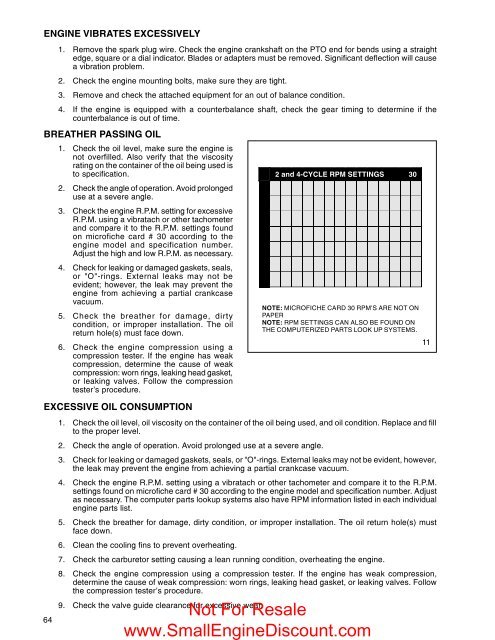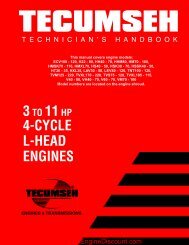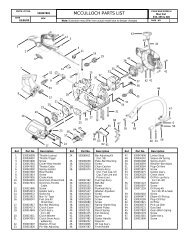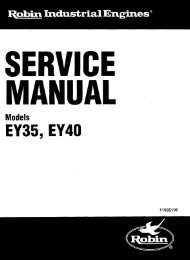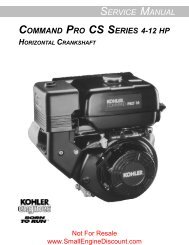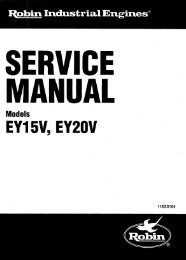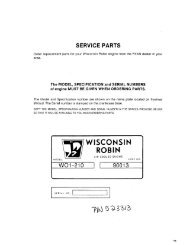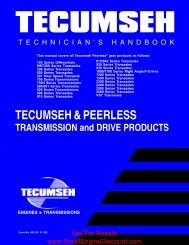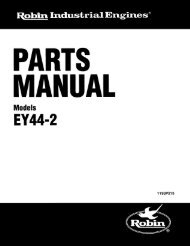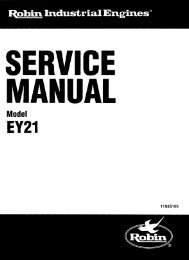4-CYCLE OVERHEAD VALVE ENGINES - Small Engine Discount
4-CYCLE OVERHEAD VALVE ENGINES - Small Engine Discount
4-CYCLE OVERHEAD VALVE ENGINES - Small Engine Discount
Create successful ePaper yourself
Turn your PDF publications into a flip-book with our unique Google optimized e-Paper software.
ENGINE VIBRATES EXCESSIVELY<br />
64<br />
1. Remove the spark plug wire. Check the engine crankshaft on the PTO end for bends using a straight<br />
edge, square or a dial indicator. Blades or adapters must be removed. Significant deflection will cause<br />
a vibration problem.<br />
2. Check the engine mounting bolts, make sure they are tight.<br />
3. Remove and check the attached equipment for an out of balance condition.<br />
4. If the engine is equipped with a counterbalance shaft, check the gear timing to determine if the<br />
counterbalance is out of time.<br />
BREATHER PASSING OIL<br />
1. Check the oil level, make sure the engine is<br />
not overfilled. Also verify that the viscosity<br />
rating on the container of the oil being used is<br />
to specification.<br />
2. Check the angle of operation. Avoid prolonged<br />
use at a severe angle.<br />
3. Check the engine R.P.M. setting for excessive<br />
R.P.M. using a vibratach or other tachometer<br />
and compare it to the R.P.M. settings found<br />
on microfiche card # 30 according to the<br />
engine model and specification number.<br />
Adjust the high and low R.P.M. as necessary.<br />
4. Check for leaking or damaged gaskets, seals,<br />
or "O"-rings. External leaks may not be<br />
evident; however, the leak may prevent the<br />
engine from achieving a partial crankcase<br />
vacuum.<br />
5. Check the breather for damage, dirty<br />
condition, or improper installation. The oil<br />
return hole(s) must face down.<br />
6. Check the engine compression using a<br />
compression tester. If the engine has weak<br />
compression, determine the cause of weak<br />
compression: worn rings, leaking head gasket,<br />
or leaking valves. Follow the compression<br />
tester's procedure.<br />
EXCESSIVE OIL CONSUMPTION<br />
1. Check the oil level, oil viscosity on the container of the oil being used, and oil condition. Replace and fill<br />
to the proper level.<br />
2. Check the angle of operation. Avoid prolonged use at a severe angle.<br />
3. Check for leaking or damaged gaskets, seals, or "O"-rings. External leaks may not be evident, however,<br />
the leak may prevent the engine from achieving a partial crankcase vacuum.<br />
4. Check the engine R.P.M. setting using a vibratach or other tachometer and compare it to the R.P.M.<br />
settings found on microfiche card # 30 according to the engine model and specification number. Adjust<br />
as necessary. The computer parts lookup systems also have RPM information listed in each individual<br />
engine parts list.<br />
5. Check the breather for damage, dirty condition, or improper installation. The oil return hole(s) must<br />
face down.<br />
6. Clean the cooling fins to prevent overheating.<br />
7. Check the carburetor setting causing a lean running condition, overheating the engine.<br />
8. Check the engine compression using a compression tester. If the engine has weak compression,<br />
determine the cause of weak compression: worn rings, leaking head gasket, or leaking valves. Follow<br />
the compression tester's procedure.<br />
9. Check the valve guide clearance for excessive wear.<br />
2 and 4-<strong>CYCLE</strong> RPM SETTINGS 30<br />
NOTE: MICROFICHE CARD 30 RPM'S ARE NOT ON<br />
PAPER<br />
NOTE: RPM SETTINGS CAN ALSO BE FOUND ON<br />
THE COMPUTERIZED PARTS LOOK UP SYSTEMS.<br />
11<br />
Not For Resale<br />
www.<strong>Small</strong><strong>Engine</strong><strong>Discount</strong>.com


